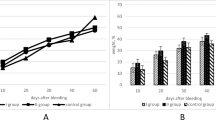Abstract
Uranium salts, such as uranyl nitrate, induce severe renal dysfunction and tubular necrosis and a significant impairment of both oxygen dependent erythropoietin production and response to recombinant human erythropoietin. All effects are transient and reach maximal severity on the 7th day post injection. We investigated the effects of ethane 1-hydroxy-1,1-bisphosphonate, which counteracts the inhibitory effect of uranyl nitrate on bone formation, on the negative erythropoietic effects of uranyl nitrate. Adult female Wistar rats received 1 mg/kg body weight of uranyl acetate by the i.v. route. Ethane 1-hydroxy-1,1-bisphosphonate was injected simultaneously at a dose of 7.5 mg/kg by the same route. Seven days after drug injections, plasma erythropoietin was estimated after hypobaric hypoxemia or cobalt chloride administration. The response to exogenous erythropoietin was also measured in uranyl nitrate- and/or ethane l-hydroxy-l,l-bisphosphonate-injected rats made polycythemic by transfusion. The erythroid response was quantitated in terms of red blood cell59iron uptake. Ethane 1-hydroxy-1,1-bisphosphonate counteracted the effect of uranyl nitrate on oxygen-dependent and cobalt-dependent erythropoietin production, but did not correct the right shift of the dose-response relationship for exogenous erythropoietin induced by uranyl nitrate in the polycythemic rat.
Similar content being viewed by others
References
Bencosme SA, Stone SR, Latta H, Madden SC. Acute tubular and glomerular lesions in rat kidney after uranium injury. Arch Pathol 1960; 69:470.
Bobey ME, Longley LP, Dicks R, Price JW, Hayman JR. The effect of uranium poisoning on plasma diodrast clearance and renal plasma flow in the dog. Am J Physiol 1943; 139:155.
Nomiyama R, Foulkes EC. Some effects of uranyl acetate salts on proximal tubular function in rabbit kidney. Toxicol Appl Pharmacol 1968: 13:89.
Giglio MJ, Bozzini CE, Barcat JH, Arrizurieta E. Relationship between severity of renal damage and erythropoietin production in uranyl nitrate-induced acute renal failure. Exp Hematol 1986: 14:257.
Giglio MJ, Brandán N, Leal T, Bozzini CE. The mechanism of the transient depression of the erythropoietic rate induced in the rat by a single injection of uranyl nitrate. Toxicol Appl Pharmacol 1989; 99:260.
Guglielmotti MB, Ubios AM, Rey BM de, Cabrini RL. Effects of acute intoxication with uranyl nitrate on bone formation. Experientia 1984:40:474.
Guglielmotti MB, Ubios AM, Cabrini RL. Alveolar wound healing under uranyl nitrate intoxication. J Oral Pathol 1985; 14:565.
Ubios AM, Guglielmotti MB, Cabrini R’L. Ethane 1-hydroxy-1.1-diphosphonate (EHDP) counteracts the inhibitory effect of uranyl nitrate on bone formation. Arch Environ Health 1990; 45:374.
Alippi RM, Boyer P, Leal T, Barceló AC, Martínez MP, Bozzini CE. Higher erythropoietin secretion in response to cobaltous chloride in post-hypoxic than in hypertransfused polycythemic mice. Haematologica 1992; 76:446.
Bozzini CE, Devoto FCH, Tomio JM. Decreased responsiveness of hematopoietic tissue to erythropoietin in acutely uremic rats. J Lab Clin Med 1966; 68:411.
Radke HW, Claussner A, Erbes PM, Schevermann EH, Schoeppe W, Koch KM. Serum erythropoietin concentration in chronic renal failure: relationship to degree of anemia and excretory renal function. Blood 1979; 54:877.
Jelkmann W, Marienhoff N, Giebelmann S, Busch L. Lowered plasma erythropoietin in hypoxic rats with kidney tubule lesions. Blut 1988; 57:317.
Haley DP. Morphologic changes in uranyl nitrate-induced renal failure in saline and water-drinking rats. Lab Invest 1982; 46:196.
Gindler JE. Physical and chemical properties of uranium. In: Hodge HC, Stannard JN, Hursch JB, eds. Uranium-plutonium transplutonic elements. Berlin Heidelberg New York: Springer: 1973:69–152.
Neuman WF, Fleming RW, Dounce AL, Carlson AB, O’Leary J, Mulryan B. The distribution and excretion of injected uranium. J Biol Chem 1948; 173:737.
McGonigle RJS, Boineau FG, Beckman B, Ohene-Frempong K, Lewy JE, Shadduck RK, Fischer JW. Erythropoietin and inhibitors of in vitro erythropoiesis in the development of anemia in children with renal disease. J Lab Clin Med 1985; 105:449.
Radke HW, Rege AB, LaMarche MB, Bartos D, Bartos F, Campbell RA, Fisher JW. Identification of spermine as an inhibitor of erythropoiesis in patients with chronic renal failure. J Clin Invest 1981; 67:1623.
Author information
Authors and Affiliations
Rights and permissions
About this article
Cite this article
Giglio, M.J., Frid, A. & Bozzini, C.E. Influence of bisphosphonate on the negative erythropoietic effects of uranyl nitrate. Int J Clin Lab Res 27, 199–201 (1997). https://doi.org/10.1007/BF02912458
Received:
Accepted:
Issue Date:
DOI: https://doi.org/10.1007/BF02912458




